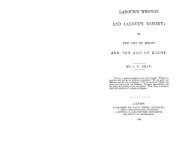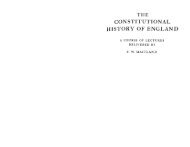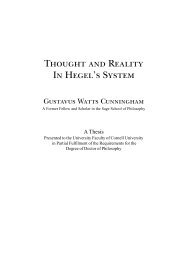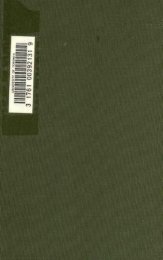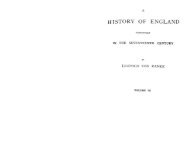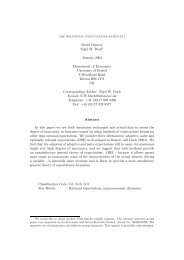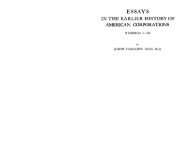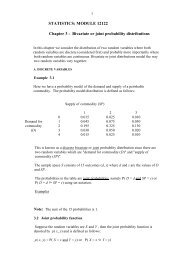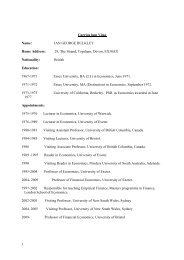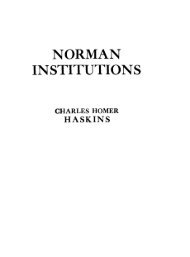164 CRAFTS AND TRADESAmong thirty-nine printing patents issued byJames I. and Charles 11. is one to " Hester Ogden,als ffulke Henr. Sibbald et Tho. Kenithorpe forprinting a book called The Sincire and True Translation<strong>of</strong> the Holy Scripture into the Englishe tounge."It appears as though Hester Ogden was no merefigure head, for His Majesty's Printers appealedagainst this licence on the grounds that it infringedtheir rights, protesting that " Mistris Ogden a mariedwoman one <strong>of</strong> Dr. Fulkes daughters did lately [sue]his Majesie to haue ye printing <strong>of</strong> her fathers workes,which his[Majestie] not knowing ye premisesgranted, and ye same being first referred [to the]Archbishop <strong>of</strong> Canterbury . . . their lordships. . . . deliuered their opinion against her,since which she hath gotten a new reference tothe Lord Chancellor and Master Secretary Nanton,who not examining ye title vpon oath and the Stationersbeing not then able to produce those material1 pro<strong>of</strong>eswhich now they can their honors certified for her,wherevpon her friends hath his Majestie's grantfor ye printing and selling <strong>of</strong> the sayed book for. . . . Mistris Ogdenxxi. years to her vsehath gotten by begging from ye clergy and othersdiuers great somes <strong>of</strong> money towards ye printing<strong>of</strong> her fathers workes. Master Norton and myselfhaue for many E~ooo bought ye <strong>of</strong>fice <strong>of</strong> hisMajesties printer to which ye printing <strong>of</strong> ye translacons<strong>of</strong> the Bible or any parts there<strong>of</strong> sett furth by theState belongs. Now the greatest parte <strong>of</strong> Dr.Fulkes worke is the new testament in English settforth by authoritie."'Another patent was granted to Helen Masonfor " printing and selling the abridgment <strong>of</strong>the book <strong>of</strong> martyres,"l while Jane, wife<strong>of</strong> Sir Thomas Bludder, petitions ArchbishopArber, Tranrcript, Vol. III., p. 39.CRAFTS AND TRADESLaud, showing that " She with John Bill an infanthave by grant from the King the moiety <strong>of</strong> the <strong>of</strong>ice<strong>of</strong> King's Printer and amongst other things the printing<strong>of</strong> Bibles. This is infringed by a printer in Scotland,who printed many Bibles there and imported theminto England . . . . she prays the Archbishopto hear the case him~elf."~Many <strong>of</strong> the books printed at this time bear thenames <strong>of</strong> <strong>women</strong> printer^,^ but though <strong>women</strong> mightown and direct the printing houses, there is no indicationthat they were ever engaged in the manualprocesses OF printing. The printers' trade does infact furnish rather a good example <strong>of</strong> the effect upon<strong>women</strong>'s economic position <strong>of</strong> the transition fromfamily industry to capitalistic organisation. It is truethat many links in the evolution must be suppliedby the imagination. We can imagine the masterprinter with his press, <strong>working</strong> at home with thehelp <strong>of</strong> his apprentice, his wife and children; thenas his trade prospered he employed journeymenprinters who were the real ctaftsmen, and it becamepossible for the owner <strong>of</strong> the business to be a man orwoman who had never been bred up to thetrade.Apprenticeship was still exacted for the journeymen.A Star Chamber decree in 1637 providesthat no " master printer shall imploy either to workeat the Case, or the Presse, or otherwise about hisprinting, any other person or persons, then suchonly as are Free-men, or Apprentices to the Tradeor mystery <strong>of</strong> Printing."' While in I 676 the Stationers'Company ordained that " no master-printer, or' Arber, Transcript, Vol. V., Ivili.S.P.D., cccxxxix., p. 89.e.g. An Essay L$ Drapery . . . by Wlliiam Scott, printed by Eliz. Aldefor S. Pennell, London, 1635 Calvin, Initrtutron <strong>of</strong> Cbrrstaan Rrltgron. Pr~ntedby the iv~dowe <strong>of</strong> R Wolfe, London, 1574. The fourtile ed~tron <strong>of</strong> Porta Lznbuarum1s printed by E. Grlffln for .M. Sparke. London, 1639.
CRAFTS AND TRADES. . . . shall teach,other printer or workmandirect or instruct any person or persons whatsoever,other than his or their own legitimate son or sons,in this Art or Mystery <strong>of</strong> Printing, who is not actuallybound as an Apprentice to some lawful authorisedPrinter."'From the omission here <strong>of</strong> any mention <strong>of</strong>daughters it is clear that the Master Printers'<strong>women</strong> folk did not concern themselves with thetechnical side <strong>of</strong> his trade ; but some attempt wasevidently made to use other girls in the unskilledprocesses, for on a petition being presented in 1635by the younger printers, concerning abuses whlchthey wished removed, the Stationers' Companyadopted the following recommendation, " That noMaster Printer shall hereafter permit or suffer bythemselves or their journeyman any Girles, Boyes,or others to take <strong>of</strong>f anie sheets from the tinpin <strong>of</strong>the presse, but hee that pulleth at the presse shalltake <strong>of</strong>f every sheete him~elf."~The young printers were successful in their effortsto preserve the monopoly value <strong>of</strong> their position,and formed an organisation amongst themselves toprotect their interests against the masters; but inthis association the wives <strong>of</strong> the young printersfound no place. They could no longer helptheir husbands who were <strong>working</strong>, not at home,but on the master's premises; and as girls were notusually apprenticed to the printing trade <strong>women</strong> werenow virtually excluded from it.Some imagination is needed to realise the socialresults <strong>of</strong> the change thus effected by capitalisticorganisation on the economic position <strong>of</strong> married<strong>women</strong>, for no details have been discovered <strong>of</strong> thel Arber, Transcript, Vol. IV., p. 534.'Ibid, Vol. I, p. 16.' S.P.D., ccci., 105, Kov. 16, 1635./CRAFTS AND TRADES~rinters' domestic circumstances; but as the wifewas clearly unable to occupy herself with her husband'strade, neither she nor her daughters could sharethe economic privileges which he won for himselfand his fellows by his organising ability. If hiswages were sufficiently high for her to devoteherself to household affairs, she became his unpaiddomestic servant, depending entirely on hisgoodwill for the living <strong>of</strong> herself and her'children;otherwise she must have conducted a business on her ownaccount, or obtained work as a wage earner, in neithercase receiving any protection from her husband in thecompetition <strong>of</strong> the labour market.The wives and widows <strong>of</strong> the Masters were meanwhileactively engaged in other branches <strong>of</strong> theStationers' Company. In a list <strong>of</strong> Publishers coveringthe years I 553-1640, nearly ten per cent. <strong>of</strong> the namesgiven are those <strong>of</strong> <strong>women</strong>, probably all <strong>of</strong> whom werewidows.' One <strong>of</strong> these, the widow <strong>of</strong> Francis Coldock,married in 1603 Isaac Binge, the Master <strong>of</strong> the Company." She had three husbands, all Bachelors andStationers, and died 1616, and is buried in St. AndrewUndershaft in a vault with Symon Burton her father.2The names <strong>of</strong> these <strong>women</strong> can be found also in thebooks they published.For example " The TrueWatch and Rule <strong>of</strong> Life " by John Brinsley the elder,printed by H. Lownes for Joyce Macham, 7th ed.1615, the eighth edition being printed for herbv T. Beale in I 61 g, and " an Epistle . . . . uponthe present pestilence " by Henoch Clapham, wasprinted by T.C. for the Widow Newber~, London,1603. A woman who was a Binder is referred toin an order made by the Bishop <strong>of</strong> London in 1685" to damask . . . . counterfeit Primmirs'seized at Mrs. Harris's Binder, "l and Women are-- -' Arber, Transcript, Vol. V., p. Ixxxi-cxi.' Ibrd, Vol. V., p. Ixiii.
- Page 1 and 2:
WORKING LIFE OF WOMENIN THESEVENTEE
- Page 6 and 7:
4 INTRODUCTORYtragic class of wage
- Page 8 and 9:
8 INTRODUCTORY INTRODUCTORYDomestic
- Page 10 and 11:
INTRODUCTORYunmarried girls go out
- Page 12 and 13:
I 6 CAPITALISTS CAPITALISTS" I loos
- Page 14 and 15:
CAPITALISTSweak woman stands in the
- Page 16 and 17:
24 CAPITALISTS CAPITALISTS 25wife t
- Page 18 and 19:
2 8 CAPITALISTS CAPITALISTS 29Majes
- Page 20 and 21:
32 CAPITALISTSA warrant was issued"
- Page 22 and 23:
CAPITALISTSbusiness. " At O~tend, N
- Page 24 and 25:
CAPITALISTS CAPITALISTS41thro' her
- Page 26 and 27:
AGRICULTUREwas made of their develo
- Page 28 and 29:
AGRICULTUREis not drye as it should
- Page 30 and 31:
52 AGRICULTURE AGRICULTUREhave of h
- Page 32 and 33:
56 AGRICULTUREfor colonists in Virg
- Page 34 and 35:
AGRICULTUREmaintain completely the
- Page 36 and 37: 64 AGRICULTUREtime was well spent i
- Page 38 and 39: AGRICULTUREExcept in exeptional cir
- Page 40 and 41: 72 AGRICULTURE AGRICULTURE 73mainta
- Page 42 and 43: 76 AGRICULTUREfor the impotent poor
- Page 44 and 45: AGRICULTUREwhich we can imagine tha
- Page 46 and 47: AGRICULTURE AGRICULTURE 85by his se
- Page 48 and 49: AGRICULTUREher work, but generosity
- Page 50 and 51: AGRICULTUREwife of Thos. Lyne. Toba
- Page 52 and 53: TEXTILESwas paid better than the la
- Page 54 and 55: TEXTILESroof provided them with the
- Page 56 and 57: 104 TEXTILESformulated by 25 Charle
- Page 58 and 59: 108 TEXTILES TEXTILES 109until the
- Page 60 and 61: TEXTILESon spinning for their livin
- Page 62 and 63: TEXTILESstill and dry within Doors,
- Page 64 and 65: 120 TEXTILES TEXTILESthe cloth made
- Page 66 and 67: 124TEXTILES TEXTILESin the closely
- Page 68 and 69: TEXTILESKingdom, it required a grea
- Page 70 and 71: 132 TEXTILES TEXTILESnot exceedl6 1
- Page 72 and 73: TEXTILES TEXTILES I37hours in four
- Page 74 and 75: ---P-I 4OTEXTILEScan be quoted of t
- Page 76 and 77: '44 TEXTILES TEXTILESWood Streate,
- Page 78 and 79: TEXTILEShigher wages than would hav
- Page 80 and 81: 1 52 CRAFTS AND TRADESdebts. For ex
- Page 82 and 83: I 56 CRAFTS AND TRADES CRAFTS AND T
- Page 84 and 85: 160 CRAFTS AND TRADES CRAFTS AND TR
- Page 88 and 89: CRAFTS AND TRADESalso met with as b
- Page 90 and 91: 172 CRAFTS AND TRADES CRAFTS AND TR
- Page 92 and 93: 176 CRAFTS AND TRADESto Henry Joyce
- Page 94 and 95: 180 CRAFTS AND TRADES CRAFTS AND TR
- Page 96: CRAFTS AND TRADESWardens and Brothe
- Page 99 and 100: P-I9OCRAFTS AND TRADESmarriage ; it
- Page 101 and 102: CRAFTS AND TRADEStaken our goods fr
- Page 103 and 104: 1g8CRAFTS AND TRADESresources turne
- Page 105 and 106: CRAFTS AND TRADESThere were fewer r
- Page 107 and 108: 206 CRAFTS AND TRADES CRAFTS AND TR
- Page 109 and 110: CRAFTS AND TRADESA large proportion
- Page 111 and 112: 214CRAFTS AND TRADES CRAFTS AND TRA
- Page 113 and 114: 218 CRAFTS AND TRADES CRAFTS AND TR
- Page 115 and 116: 222 CRAFTS AND TRADES CRAFTS AND TR
- Page 117: CRAFTS AND TRADES CRAFTS AND TRADES
- Page 120 and 121: CRAFTS AND TRADESfrom her fellow pa
- Page 122 and 123: PROFESSIONS 237PROFESSIONSIntroduct
- Page 124 and 125: 24O PROFESSIONS PROFESSIONStheir Th
- Page 126 and 127: 244 PROFESSIONS PROFESSIONS 245the
- Page 128 and 129: PROFESSIONS PROFESSIONS 249profanat
- Page 130 and 131: 252PROFESSIONSGiles Moore enters in
- Page 132 and 133: PROFESSIONScribed as one who " dist
- Page 134 and 135: PROFESSIONS PROFESSIONS 261first ma
- Page 136 and 137:
264 PROFESSIONSGarrett's leg shall
- Page 138 and 139:
268 PROFESSIONSwhere there are none
- Page 140 and 141:
PROFESSIONS PROFESSIONS 273the numb
- Page 142 and 143:
PROFESSIONSexaminations, before six
- Page 144 and 145:
PROFESSIONS PROFESSIONS 281death me
- Page 146 and 147:
284 PROFESSIONS PROFESSIONSof confi
- Page 148 and 149:
288 PROFESSIONSextent they were whe
- Page 150 and 151:
CONCLUSIONor in her other facilitie
- Page 152 and 153:
CONCLUSION CONCLUSION 297in women's
- Page 154 and 155:
CONCLUSIONlaw of Nature, inviolable
- Page 156 and 157:
CONCLUSIONwere specially deprecated
- Page 158 and 159:
308 CONCLUSIONof the State, and the
- Page 160 and 161:
312 AUTHORITIES AUTHORITIES 313Cost
- Page 162 and 163:
AUTHORITIESMartindale, Adam, The Li
- Page 164 and 165:
County.Buckingham ..Cardigan .. ..C
- Page 166 and 167:
INDEXINDEXFlax, 64, 146, 246, 291 ;
- Page 168:
INDEXsmants, women( 50,65,157 ; mam



